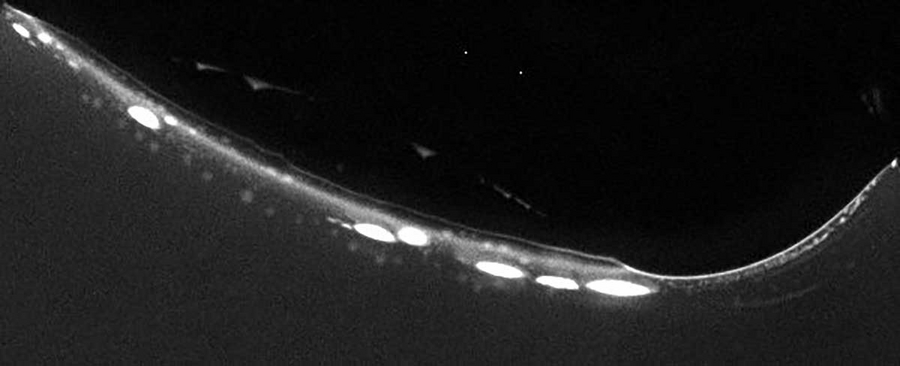
Fluorescence microscopy image of protocells in contact with a gas bubble. Coacervate assemblies are a valid model to mimic the first protocells that arose on Early Earth and to study how the first steps of life could have evolved. Copyright: Alan Ianeselli / LMU
Where and how did life begin on Early Earth more than 3.5 billion years ago from non-living chemicals? Discovering the answer to this question has long been debated and is a challenge for scientists. One thing that scientists can look for is potential environments that allowed life to spark. A key necessity for the first cells on Earth is the ability to make compartments and evolve to facilitate the first chemical reactions. Membraneless coacervate microdroplets are excellent candidates to describe protocells, with the ability to partition, concentrate molecules and support biochemical reactions. Scientists have not yet shown how those microdroplets could have evolved to start life on earth. Researchers at the Max Planck Institute of Molecular Cell Biology and Genetics (MPI-CBG) in Dresden and at the Center for NanoScience (CeNS) at the Ludwig-Maximilians-Universität (LMU) in Munich now demonstrate for the first time, that the growth and division of membraneless microdroplets is possible in an environment which is similar to gas bubbles within a heated rock pore on Early Earth. Suggesting that life may have had its origin there.
The team around Dora Tang, a research group leader at the MPI-CBG, showed in 2018 that simple RNA is active within membraneless microdroplets, enabling a suitable chemical environment for the beginning of life. Those experiments were conducted in a simple aqueous environment, where competing forces were balanced. Cells, however, need an environment where they can continuously divide and evolve. To find a more suitable scenario for the origin of life experiments, Dora teamed up with Dieter Braun, professor for Systems Biophysics at the LMU in Munich. His group developed conditions with a non-balanced environment that allow multiple reactions in a single setting and where cells could evolve. Those cells though are not like the cells we know today, but more like precursors to today’s cells, also called protocells, made of coacervates with no membrane.
The environment, created by the Braun lab is a likely scenario on Early Earth, where porous rocks in water in proximity of volcanic activities were partially heated. For their experiments, Dora and Dieter used water-containing pores with a gas bubble and a thermal gradient (a hot and a cold pole) in order to see if the protocells would divide and evolve. Alan Ianeselli, first author of the study and PhD student in the lab of Dieter Braun, explains: “We knew that the interface of the gas and the water attracted molecules. Protocells localize and accumulate there, and assemble into larger ones. This is why we chose this particular setting.” The researchers indeed observed that molecules and protocells went to the gas-water interface to form larger protocells out of sugar, amino acids and RNA. Alan continues: “We also observed that the protocells were able to divide and fragment. These results represent a possible mechanism for the growth and division of membrane-free protocells on the Early Earth.” In addition to division and evolution, the researchers found that as a consequence of the thermal gradient, several types of protocells with different chemical composition, size and physical properties had formed. Therefore, the thermal gradient in this environment could have driven an evolutionary selection pressure on membraneless protocells.
Dora Tang and Dieter Braun, who supervised the study, summarize: “This work shows for the first time that the gas bubble within a heated rock pore is a convincing scenario for the evolution of membrane-free coacervate microdroplets on Early Earth. Future studies could focus on more possible habitats and explore further conditions for life to emerge.”
Alan Ianeselli, Damla Tetiker, Julian Stein, Alexandra Kühnlein, Christof Mast, Dieter Braun and T-Y Dora Tang: “Non-equilibrium conditions inside rock pores drive fission, maintenance and selection of coacervate protocells”, Nature Chemistry, 06. December 2021, doi: 10.1038/s41557-021-00830-y
Media Contact MPI-CBG
Katrin Boes
+49 (0) 351 210 2080
kboes(at)mpi-cbg.de
Further Information:
Dr. Dora Tang
MPI-CBG
+49 (0) 351 210 2560
tang(at)mpi-cbg.de
Prof. Dieter Braun
LMU
49 (0)89 2180-2317
dieter.braun(at)lmu.de